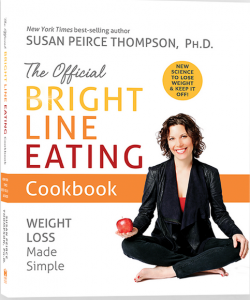 I mentioned the Bright Line Eating Program previously, as a tried-and-true way to achieve healthy eating habits and sustain a healthy weight. This week, the program’s founder, Susan Peirce Thompson, was interviewed on the Today show.
I mentioned the Bright Line Eating Program previously, as a tried-and-true way to achieve healthy eating habits and sustain a healthy weight. This week, the program’s founder, Susan Peirce Thompson, was interviewed on the Today show.
If you need to lose weight—or even if you don’t but struggle with sugar or other food addictions—view Susan’s interview here. Decide for yourself if you could benefit from this program. But attention—it’s for people who seriously want to lose the weight once and for all, kick food addictions, and are willing to commit to three rules, or “bright lines.”
- Don’t eat sugar or flour (no matter what).
- Only eat at meal times, three meals a day, with 4-6 hours between eating. No grazing.
- Weigh your food, eating measured portions of real food, according to nutritional needs (no processed foods or unhealthy fats).
Once you set up a plan that’s right for you, you commit to it and stick to it. If you think that’s hard (and it can be), Susan’s program is set up with private social media groups and social support. They also include trained helpers who can help you stay on program.
I’ve seen and experienced a lot of weight loss programs, Bright Lines is the only one I’ve heard of that addresses the psychology of eating and the addictive nature of food. I know it works, I’ve seen it for others and experienced it myself. I’m not an affiliate or selling anything. I simply believe in it’s success with some pretty experienced overweight people.
Check out the interview on the Today show and learn more about it.
Bright Lines Eating Targets Food Addictions
We now know that eating sweet foods stimulates the reward pathways in the brain, releasing “feel-good” chemicals such as dopamine, serotonin and endorphins. It feels so good that we want more.
Our ancestors knew that fruit came into season before the winters when food was scarce. They would gorge themselves to gain weight to hold them over the long, cold season. That’s how it became an evolutionary advantage to have brains wired with reward pathways.
You may experience these same biochemical urges even though fruit and sweet foods are available year-round. But this is no longer a good idea, because—unlike our primitive ancestors—we don’t risk starvation due to cold weather and a lack of food.
What many of us don’t know is that refined and processed wheat and flour (high-carbohydrate foods) also stimulate those same reward pathways in the brain. That’s why we rarely eat one slice of pizza. All high carbohydrate foods can be addictive but especially those that contain flour, fat, and added sugar.
I Want More, Please
The problem with stimulating the reward pathways is that dopamine is released into the brain. Dopamine is the neurotransmitter of “MORE,” it gives us the experience of craving. It doesn’t tell us we are satiated. Only that we need more to feel better.
What happens in the brain when we feed it a substance that tickles our dopamine receptors? They eventually get overwhelmed and tired and shut down. In other words, we need more of the substance to feel the same reward we previously felt. This is the same thing that happens when people get addicted to drugs or alcohol.
That’s why setting up a structured eating plan helps to override the pull of addictions. That helps, along with social support of others on the same path. It’s the same type of program for other addictions that has helped people recover from drugs and alcohol.
I know so many seniors who have struggled with weight issues and who’ve tried diets and failed. The Bright Lines eating program is one that can finally help. Check it out.

Recent Comments